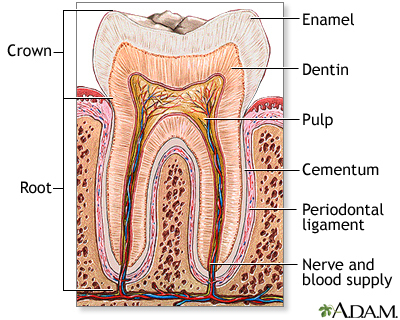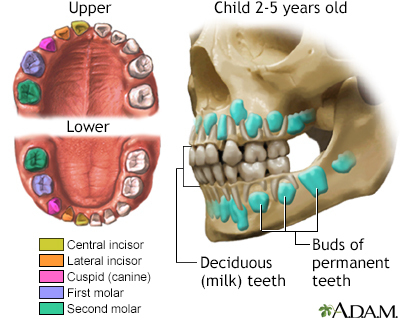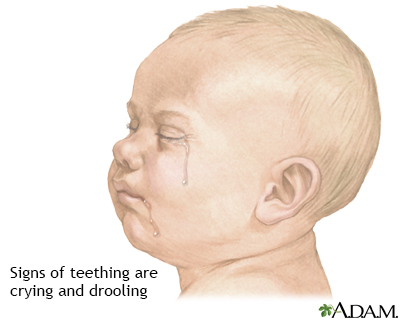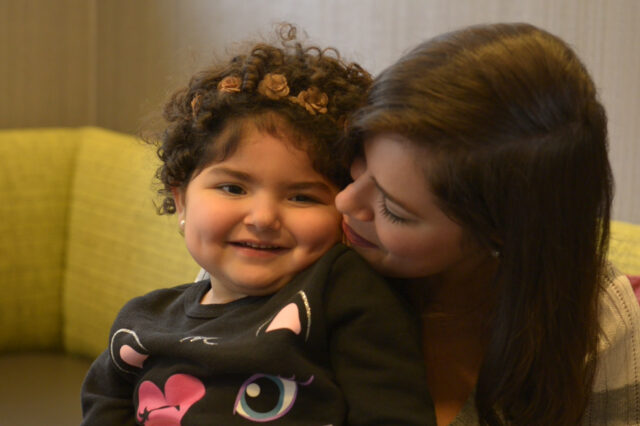- Investigator
- Stephanie Ihnow
- Status
- Accepting Candidates
Teething
Definition
Teething is the growth of teeth through the gums in the mouth of infants and young children.
Alternative Names
Eruption of primary teeth; Well child care - teething
Information
Teething generally begins when a child is between 6 and 8 months old. All 20 baby teeth should be in place by the time a child is 30 months old. Some children do not show any teeth until much later than 8 months, but this is usually normal for the child and not due to a disease.
- The two bottom front teeth (lower incisors) often come in first.
- Next to grow in are usually the two top front teeth (upper incisors).
- Then the other incisors, lower and upper molars, canines, and finally the upper and lower lateral molars come in.
The signs of teething are:
- Acting cranky or irritable
- Biting or chewing on hard objects
- Drooling, which may often begin before teething starts
- Gum swelling and tenderness
- Refusing food
- Sleeping problems
Teething does not cause fever or diarrhea. If your child develops a fever or diarrhea and you are worried about it, talk to your health care provider.
Tips to ease your child's teething discomfort:
- Wipe your child's face with a cloth to remove the drool and prevent a rash.
- Give your child a cool object to chew on, such as a firm rubber teething ring or a cold apple. Avoid liquid-filled teething rings, or any plastic objects that might break.
- Gently rub the gums with a cool, wet washcloth, or (until the teeth are right near the surface) a clean finger. You may place the wet washcloth in the freezer first, but wash it before using it again.
- Feed your child cool, soft foods such as applesauce or yogurt (if your child is eating solids).
- Use a bottle, if it seems to help, but only fill it with water. Formula, milk, or juice can all cause tooth decay.
You can buy the following medicines and remedies at the drug store:
- Acetaminophen (Tylenol and others) or ibuprofen can help when your child is very cranky or uncomfortable.
- If your child is 2 years or older, teething gels and preparations rubbed on the gums may help the pain for a short while. Be careful not to use too much. Do not use these remedies if your child is younger than 2 years old.
Be sure to read and follow package instructions before using any medicine or remedy. If you are not sure how to use it, call your child's provider.
What not to do:
- Do not tie a teething ring or any other object around your child's neck.
- Do not place anything frozen against your child's gums.
- Never cut the gums to help a tooth grow in, because this can lead to infection.
- Avoid teething powders.
- Never give your child aspirin or place it against the gums or teeth.
- Do not rub alcohol on your child's gums.
- Do not use homeopathic remedies. They may contain ingredients that are not safe for infants.
Gallery



References
American Academy of Pediatrics website. Teething: 4 to 7 months. www.healthychildren.org/English/ages-stages/baby/teething-tooth-care/Pages/Teething-4-to-7-Months.aspx. Updated October 6, 2016. Accessed November 29, 2022.
American Academy of Pediatric Dentistry. Policy on oral health care programs for infants, children, adolescents, and individuals with special health care needs. The Reference Manual of Pediatric Dentistry. Chicago, IL: American Academy of Pediatric Dentistry; 2020:39-42. www.aapd.org/globalassets/media/policies_guidelines/p_oralhealthcareprog.pdf. Updated 2020. Accessed November 29, 2022.
Turner EG, Dean JA. Eruption of the teeth: local, systemic, and congenital factors that influence the process. In: Dean JA, ed. McDonald and Avery's Dentistry for the Child and Adolescent. 11th ed. St Louis, MO: Elsevier; 2022:chap 20.
Related specialties
Clinical Trials: Teething
UF Health research scientists make medicine better every day. They discover new ways to help people by running clinical trials. When you join a clinical trial, you can get advanced medical care. Sometimes years before it's available everywhere. You can also help make medicine better for everyone else. If you'd like to learn more about clinical trials, visit our clinical trials page. Or click one of the links below:
News and Patient Stories: Teething
Surgeons Save Newborn Suffering From Spina Bifida
Lindsey Courson of Tallahassee was 26 and expecting her second child. Her first, a little boy named Camden, was a healthy, rambunctious 1 ½-year-old, and she…

From teething to transplant: Izabella’s Journey
Celebrating 10 Years of Healing Hearts at the UF Health Congenital Heart Center In December of 2011, Krystina Lopez was given little hope that her twin…

Latest podcast episodes
Ancient teeth aid modern health
Neanderthals walking the earth 100,000 years ago and more recent ancient humans had tartar and dental plaque just like modern folks. Minus the dentist, of course. At first blush, it’s difficult to...
Teeth-grinding a new consequence of the pandemic
By now, it’s hardly a news flash that the coronavirus pandemic has raised stress levels for nearly everyone. People are well-aware of the heightened anxiety in their lives, and new research shows...
Wisdom teeth extraction linked to opioid addiction among young people
The epidemic of opioid addiction is ravaging this country, and new research has pointed to a trouble spot few might have anticipated. Young people are at a greater risk of opioid addiction if they...